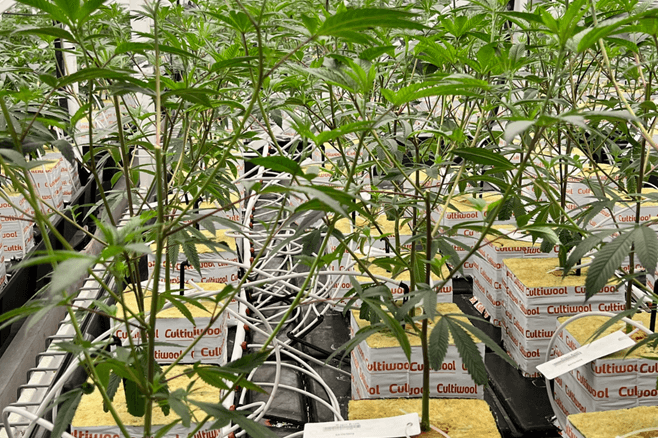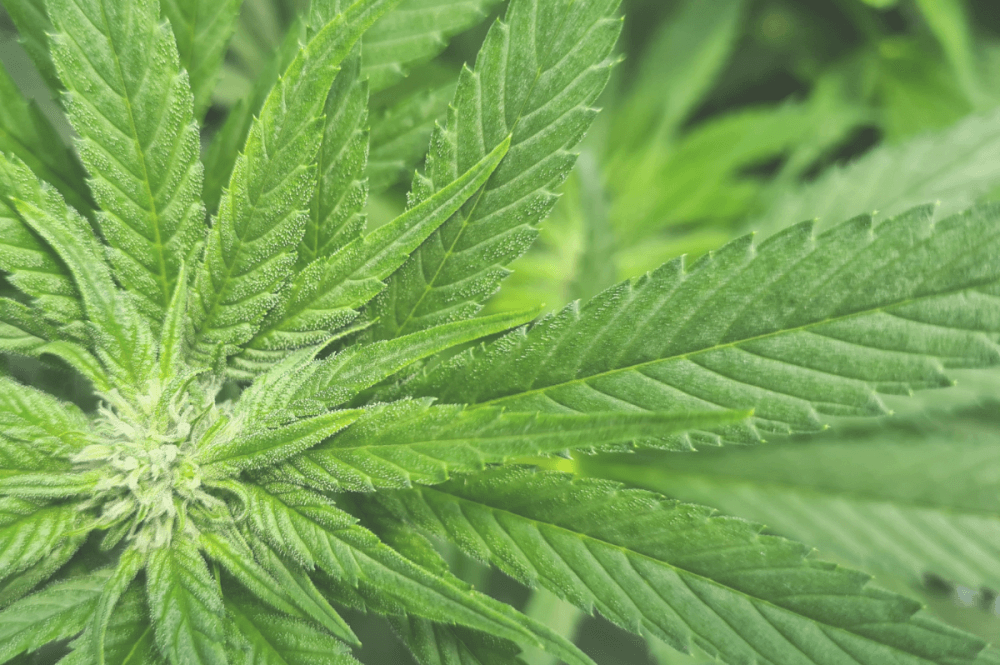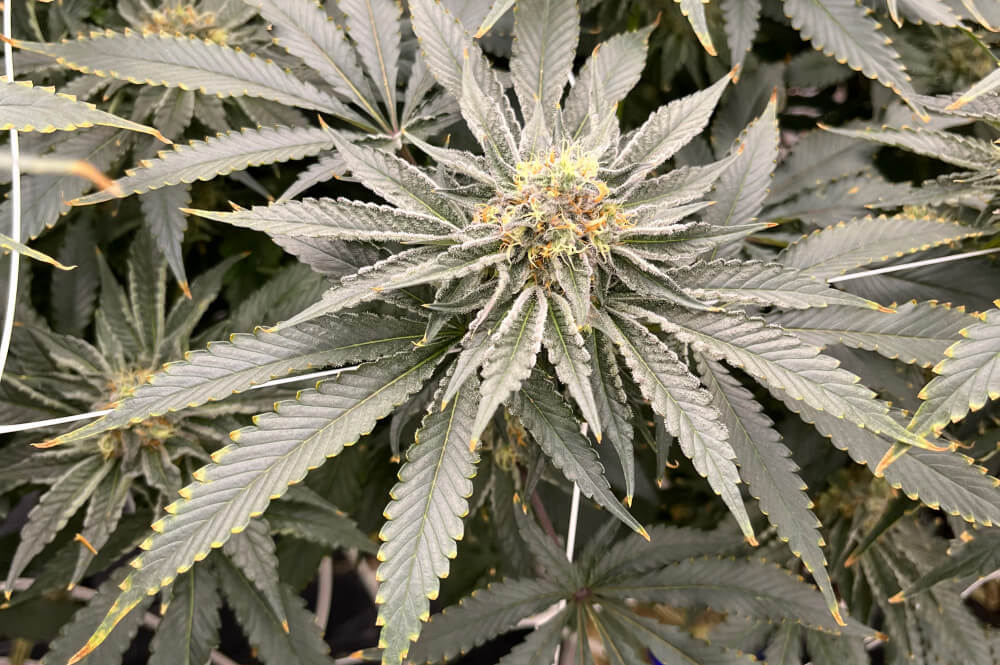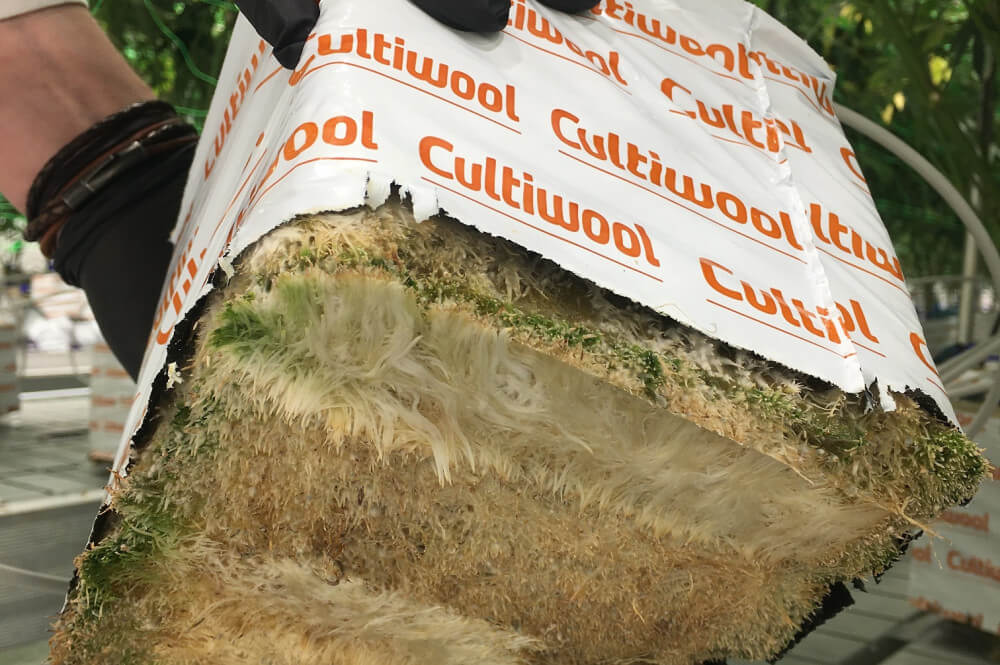.jpg)
The science behind your No.1 growing power

VPD & Root-Zone Balance – Why Climate Control Matters in Stone Wool Cultivation
Vapor Pressure Deficit (VPD) has become one of the most discussed parameters in modern greenhouse and indoor cultivation. It provides growers with a more precise way to understand how plants interact with their environment. Specifically, how temperature and humidity, along with leaf temperature, drive transpiration. While often discussed in the context of climate control, VPD also has a direct impact on root-zone management, especially when using high-precision substrates like stone wool. In this article, we will explore the technical fundamentals of VPD, how it influences plant physiology, and most importantly, how growers can align VPD management with irrigation strategies in stone wool to achieve optimal growth and consistency.

Advanced Nutrient & Crop Steering Techniques in Stone Wool Cultivation
Stone wool has become the preferred substrate for precision cultivation, offering growers unparalleled control over water, nutrients, and oxygen availability at the root zone. As controlled environment agriculture (CEA) advances, one of the most impactful strategies growers can adopt is crop steering. That is a data-driven approach to adjusting environmental and nutritional inputs to guide plant development toward desired outcomes. Whether targeting higher biomass, increased yield, or enhanced quality (such as flavor or cannabinoid concentration), crop steering techniques can transform results in both medicinal and food crop production.

Avoiding the Top 5 Mistakes When Growing in Stone Wool
Stone wool is a powerful and precise substrate that enables growers to fine-tune plant development with unparalleled control. However, with this precision comes the need for accuracy at every step of the growing process. At Cultiwool, we have seen how easily small mistakes can lead to big inefficiencies or lost yields, especially in high-density, high-value crops like cannabis. Whether you are an experienced cultivator scaling operations or just starting with stone wool, here are the five most common mistakes we see, and how to avoid them.

Substrates side-by-side; How Do I Choose the Substrate Best Suited to my Situation?
At Cultiwool, we are frequently approached by growers who want to do a side-by-side of the substrate they are using and Cultiwool. We are happy to facilitate these trials, even provide support on their success. However, there are some common improvements we see across the board that can raise the quality of the trials and improve your decision-making. Therefore, we have written this article to help set up the perfect substrate trial in a facility.

All There is to Know about Cultiwool Stone Wool VS. Organic Substrates
Cultiwool stone wool is the growing media of choice for growers looking to grow a healthy and uniform crop. Stone wool is made from rocks such as basalt and anorthosite. The rocks start to melt around 1,600°C (2,912°F). From the liquefied rock, fibers are spun and specialized binders as well as wetting agents are added, resulting in large boards of Cultiwool stone wool.
![differencebetweensquareandroundpropagationplugs cultiwool[1] differencebetweensquareandroundpropagationplugs cultiwool[1]](https://www.cultiwool-substrate.com/cache/e3ad28090b1d617ced74d6b17dc4128c/differencebetweensquareandroundpropagationplugs-cultiwool[1].png)
What is the Difference Between Square and Round Propagation Plugs?
From a young age, we were taught not to try to fit a square into a circle. Child games utilizing different shapes emphasized this even more with specific shaped objects only fitting in the same shaped hole. And thus comes one of the most common stone wool questions we get. Why do people use a square propagation plug (AO) when the hole in the block is round? Well, there are a couple of different reasons why one might choose to use either a square Cultiwool plug (AO) or a round Cultiwool plug (i.e., macroplug). This article will elaborate on these reasons;

Discussing Substrates, Operations, and More; Interview with GreenLeaf Medical
GreenLeaf Medical started in 2017 and has grown tremendously since then, growing and selling a full range of products to the medicinal market within the USA. Samer Abilmona has been in the cannabis industry for a little over 10 years, but he has cultivated cannabis for the majority of his adult life. He has been the Executive Director of Cultivation and Operation of GreenLeaf Medical since 2019, then the company consisted of one cultivation facility, started to work on the second, had one dispensary in Maryland, and recently received a license in Virginia. Nowadays, the company is a multi-state operator, with facilities in Virginia, Pennsylvania, and Maryland. The cultivation is tailored to their market leader, smokable flowers. Other products within their range are live resin, live rosin, and distillates for vape cartridges as well as for edibles. About 6 months ago GreenLeaf Medical merged with Columbia Care, now the Cannabist Company, Samer has been managing a few additional cultivation and extraction facilities in West Virginia, two facilities in Washington DC, and a second Virginia location.

Understanding and Mitigating Channeling in Stone Wool Substrate
Stone wool substrate has gained popularity in horticulture due to its excellent water retention and air porosity characteristics, which are essential for healthy plant growth. However, one common issue that growers often encounter when using stone wool is channeling. Channeling refers to the inefficient distribution of water and nutrients within the substrate. In this article, we will explore what channeling is, what typically happens when it occurs, how to identify its signs, and discuss methods to prevent it. We will also delve into why some stone wool products are more prone to channeling than others and explore the role of binders and wetting agents. Finally, we will touch upon the importance of choosing the right irrigation system to avoid channeling.

What is Slag Wool and How does it Differ from High-Quality Horticultural Stone Wool?
As more and more products and companies become available on the market, it is always important to do a little research. Not only on the company itself but how the products are being produced. A little bit of research and asking the right questions can save money and time, but maybe the most important, the crop and your investment.

Magnesium Deficiency in Cannabis in Relation to Light Strategy
Cannabis cultivation is a complex process, with many different factors affecting the growth and development of the plant. One of the most important aspects to consider to allow cannabis plants to thrive is the nutrient balance within the growing medium. Among these essential nutrients is magnesium, a mineral that plays a critical role in plant growth and development. In this article, we'll take a closer look at magnesium deficiency in cannabis cultivation. This article is the last one of the sequence written following an interview with Ryan Wankel.

Dry Backs and Their Benefits for Your Cannabis Cultivation
“I think dry backing is probably one of the techniques that a lot of growers use to increase cannabinoids and flavonoids content” Ryan mentioned. But how does it work and what does it really mean? This article is a continuation of the previous one, following an interview with Ryan Wankel, and will focus on the cultivation manipulation known as Dry Backs.

The Influence of Higher Light Levels on the Irrigation Strategy for Cannabis Cultivation
Cannabis is known to be a highly demanding crop, but what does it mean for growers' irrigation and lighting strategies? We wanted to know how does high light strategy influence the irrigation strategy for cannabis cultivation on stone wool? Therefore, for this article, we interviewed Ryan Wankel, our technical sales manager for North America.

Stone Wool and Cultivation Efficiency
What will happen to my cultivation when I start using stone wool? This question and many others are often asked by experienced growers that want to improve their cultivation efficiency. Therefore, this article explains why and how the transition from soil-like substrates to stone wool upgrades your cultivation efficiency.
![facebookpost20[1] facebookpost20[1]](https://www.cultiwool-substrate.com/cache/04bb2be497879e33068e2df76cc44232/facebookpost20[1].png)
AO Starter Plugs Instructions
To start successful cannabis cultivation the Starter Plugs are a must. In order to reach the best results, it is recommended to follow this easy yet important instruction guide with attention to the small details.

The Effect of pH Levels on Cannabis Cultivation; What Should it Be?
Previous articles discussed aspects such as the importance of a correct irrigation scheme, daily dynamics in the stone wool, EC levels monitoring and adjustments, and more. Yet, there is one more important point to discuss, and it is the pH level.
![cultiwool sense nl[1] cultiwool sense nl[1]](https://www.cultiwool-substrate.com/cache/1b9025904a6a2b9d397574ae8efeece5/cultiwool-sense-nl[1].png)
EC in Cannabis Cultivation; What to Control, Measure, and Adapt
EC is the abbreviation for the term electrical conductivity, which is a very important aspect to take into consideration when growing plants.

The Daily Dynamics Within the Root Zone of a Cannabis Plant When Grown on Stone Wool
Previous articles have presented, among others, information regarding the importance of irrigation strategies, crop steering, measuring WC and EC in the stone wool, and more. In this article we discuss the ideal 24-hours irrigation dynamics for cannabis cultivation on stone wool.

Vegetative and Flowering Stages of Cannabis on Stone Wool
Do you know what has to be taken in account for succesful cultivation? In this knowledge article we will tell you everything you need to know from the end of the propagation stage to the vegetative and flowering stages in cannabis cultivation.
![cloning4x4miniblock[1] cloning4x4miniblock[1]](https://www.cultiwool-substrate.com/cache/922001910e85cbeae412439f8ff771c0/cloning4x4miniblock[1].png)
Stone Wool for Cannabis Propagation from Seed and Vegetative Cuttings
Successful cannabis propagation starts with high-quality plugs for cloning or sowing. Whether starting from seed or vegetative propagation in the form of cuttings, there is high importance to use the right and most suitable growing medium.

Precision Growing; What Should be Measured in the Substrate, How to Do That, and Why?
The importance of WC, EC, and pH for cannabis cultivation was discussed in previous articles. As it was mentioned, there are several target levels to maintain in the stone wool; WC between 50 to 90%, EC of minimum 1.5 mS/cm in propagation, and about 2.5-2.8 mS/cm for the solution during vegetative to flowering (and an EC of the substrate between 3 to 6 mS/cm), and a pH between 5.5 to 5.8.

Irrigation Strategies for Cannabis Cultivated in Stone Wool
One of the most interesting characteristics of stone wool is its ability to extract water at very low moisture content levels. Stone wool is able to take up water instantaneously when partially dried out, unlike other substrates where plant wilting would be inevitable. Furthermore, there is a moisture gradient from top to bottom. Where the top is drier to allow for aeration (which also makes the substrate ideal for hydroponic cultivation). Nevertheless, growers who are unaware of this characteristic of stone wool might be in the illusion of stone wool drying out too fast, risking over-irrigation, therefore, good understanding and knowledge about stone wool is required.

Water Content, EC, and pH in Stone Wool for Cannabis
When handling the stone wool right, important aspects such as water content (WC), electrical conductivity (EC), and pH, can easily be monitored and adjusted when needed. The reason these aspects have to be closely looked at is their heavy influence on crop health, growth, and development. There are several things that can be adjusted to influence the WC, EC, and/or pH in the stone wool, such as irrigation amount, schedule, and the given nutrient recipe. This is what we called steering the crop with irrigation and stone wool offers this wide range of control.

Stone Wool Saturation: Why it is Important and How to do it Right
Similarly to other growing media, when stone wool is delivered it is dry, meaning, it contains 0% water. In comparison to other substrates, stone wool has many advantages, such as lighter weight, a great moisture holding capacity, more convenient transportation, and longer shelf-life for unused products. Therefore, when a grower plans to start the cultivation of cannabis, the first step (and a very critical one) is to initially saturate the stone wool.

Why Stone Wool Comes in Different Sizes and Shapes?
Producing sustainable and high-quality cannabis comes down to making the right choices, before, during, and after cultivation. Before cultivation, a considerate step-wise approach is taken in choosing the best equipment to successfully cultivate cannabis. First and foremost this starts with the choice of the most suitable substrate, as the choice of substrate will determine to what degree water and nutrients will be available to the plants, allowing for vigorous growth and healthy development.
.png)
Stone wool: Unique Product Features of Our Blocks
There are many aspects affecting the decision of which substrate to use, among these crop types and cultivation stages. Similarly to the way soil mixtures can be amended and customized, so are stone wool products tailor-made for the cultivation of a specific variety of crops. Stone wool can be manufactured in such a way that the density and orientation of the molten rock fibers determine the moisture holding capacity, air-filled porosity, and moisture gradient within the blocks.
.jpg)
What is Stone Wool?
The global demand for healthy, safe, fresh, and local produce has been rapidly increasing. Among many things, it requires nutritious produce and a sustainable approach to cultivation. Sustainability can be defined in several ways, but an Important one is reduction of the carbon footprint and/or use of resources such as water and fertilizers. As water scarcity is becoming more pronounced and soils turn more saline, optimal use of water is required as well as reducing emissions into the environment becomes a necessity and a daily task for growing businesses. Horticultural approaches offer a wide variety of applicable cultivation systems, from which substrate choice is leading in water and fertilizer use efficiency.

Where can I find Cultiwool?
Discover more about our Cultiwool network

